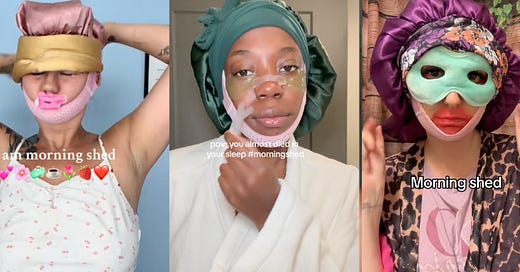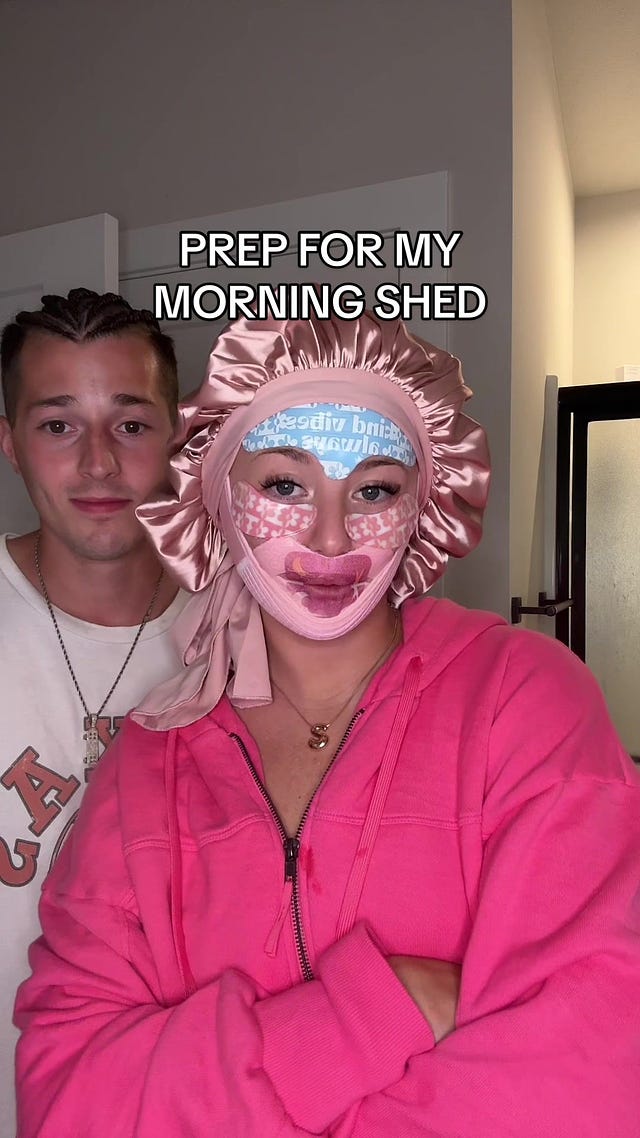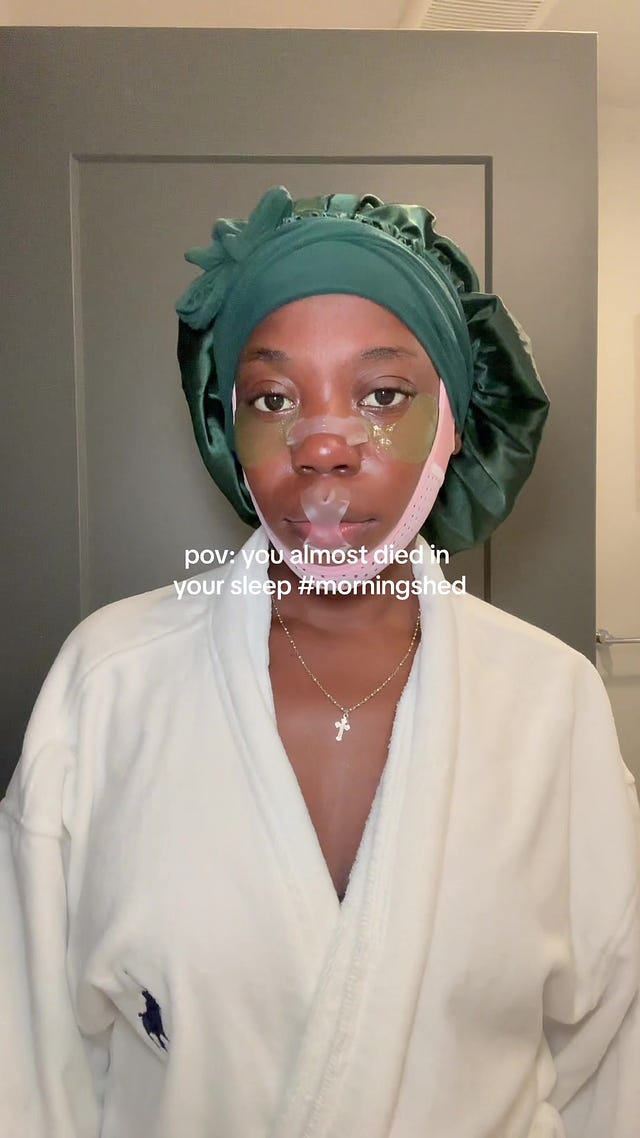The Morning Dread (— I Mean, Shed)
An interview on the morning shed, with Sara Radin for Vogue.
In “The Morning Shed and the Endless Quest to Be Perfect,” Vogue reporter Sara Radin explores the morning shed: “a new trend signifying our morbid desire to be ‘perpetually hot.’”
I’m sure you’ve seen the shedders by now, on TikTok or Instagram or maybe in your own mirror. They pile on beauty products before bed — creams, sheet masks, under-eye masks, lip stains, mouth tape, chin straps, and more — adopting a look that is, as
observed in our last podcast, vaguely “post-op” without the op. They go to sleep, covered in stuff. Come morning, they record the removal of each layer and reveal the (anticipated, if not actual) results: smoother skin, plumper lips, sharper jawlines, etc. There are 75,000,000 videos like this on TikTok alone. Tiktok failed to load.
Tiktok failed to load.Enable 3rd party cookies or use another browser
I was thrilled when Radin reached out to interview me for the article. (Read it!) Since our full Q&A didn’t make the final cut though, I figured I’d share the rest of my answers with you here. Continue reading for more on the origins of the morning shed, the commodification of the dream space, and the futility of multi-step skincare routines.
Sara Radin: How would you describe this trend? What does it entail? Where and when did you first start seeing it?
Jessica DeFino (me): I would describe the morning shed trend as sad, primarily — a way to fill even our precious sleeping hours, when we could and should be blissfully unaware of the otherwise constant and unrelenting pressures of beauty culture, with aesthetic labor. I started noticing the trend a month or so ago — someone sent me an Instagram post about it. The video showed a woman doing her "daily shed," and I think she used phrases like "being high maintenance to be low maintenance" and also "go to bed ugly to wake up beautiful."
SR: Who do you think is pushing it forward?
JD: I would say beauty culture is pushing it forward — beauty culture being this sort of ambient but all-consuming societal force that compels us to focus on being as beautiful as possible at all times. I think the beauty industry is pushing it forward by providing people with a never-ending stream of products and procedures to manipulate their physical appearance to be more in-line with the current Western standard of youthful beauty (which is predicated on product/procedural intervention). I think influencers are pushing it forward, because the videos make for good entertainment, but also so are the regular people consuming and sharing these videos (and mimicking the behavior in their own lives).
The merging of the beauty and wellness industries is part of this, too. Over the past couple years in the wellness space, we saw a huge focus on sleep. The beauty industry glommed onto that and started producing and pushing products to use while sleeping, and it spiraled from there.
SR: What's the goal or point of this trend? What's the deeper meaning behind it?
JD: I think the goal or point of this trend, as I saw it put in a couple of videos, is to be “high maintenance” or “ugly” when (theoretically) no one is looking: at night, getting ready for bed, when you're sleeping — in order to appear "low maintenance" and effortlessly beautiful when (theoretically) people are looking: in your waking hours. This is absurd. There is no such thing as being high maintenance to be low maintenance, or putting in effort to be effortless — there is only high maintenance, there is only effort. The amount of work being put in remains high, even if it looks easy once it's done.
Many morning shed videos also feature audio from an old “Sex and the City” episode, a voiceover of Carrie Bradshaw saying, “Maybe you have to let go of who you were to become who you were meant to be.” Obviously, this is a little tongue-in-cheek, but still, in some sense, it creates a dissociative distance from the effort involved — posters are using the clip to de-identify with the version of themselves that used all those products, and re-identify with the version of themselves that seems not to need anything. The implication isn’t far off from mainstream beauty culture rhetoric— that the “ugly” version of you isn’t real, that becoming the real you hinges on becoming beautiful.
As far as the deeper meaning behind it: This trend shows that there is not a single moment of our lives that hasn't been commodified, and there is not a single experience that hasn't been co-opted, for the project of becoming as “beautiful” as possible.
SR: Is there any proof that aspects of this trend are beneficial or actually work?
JD: Besides sleeping? No.
SR: What's your hot take on the toxicity of this trend?
JD: I'm not too fired up about this one right now. To me, it just seems like a depressing way to exploit the dream space :)
SR: What's the problem with multi-step skincare routines? Do you think this could border on obsessive/compulsive behavior and if so how?
JD: The problem with excessive, multi-step skincare routines is that they're really not based in the science of skin functioning. Interview any dermatologist (who is not also an influencer or shilling products), and they will tell you the best thing you can do for your skin is simplify your routine. Interview any dermatologist (who is not also an influencer or shilling products) and they will tell you one of the worst things you can do for your skin is use too many products. Excessive skincare use can trigger inflammation (dermatitis, eczema, psoriasis, rosacea, acne), disrupt the skin barrier, disturb the skin microbiome, lead to sensitivity, and more. The skin really does not need much in order to function. The problem is, the skin does need a lot in order to meet the unreasonable standard of beauty we're held to today. But in terms of healthy, functioning skin, not much is needed at all.
Because it's not rooted in health or functioning, I do think this trend can border on obsessive or compulsive. Collectively, it seems that beauty enthusiasts cannot stop themselves from buying and applying beauty products — even when dermatologists tell them not to, even when common sense shows it's a bad idea, even when basic logic disputes asinine sayings like "be high maintenance to be low maintenance." We buy and apply anyway.
This interview has been edited for clarity.






The amount of single-use products involved in this latest beauty nightmare makes me gag
As a boomer feminist, it is so infuriating to see young women being conned by capitalism. Beautiful young women are bankrupting themselves to chase an impossible ideal. All that money would be better spent on a retirement fund.